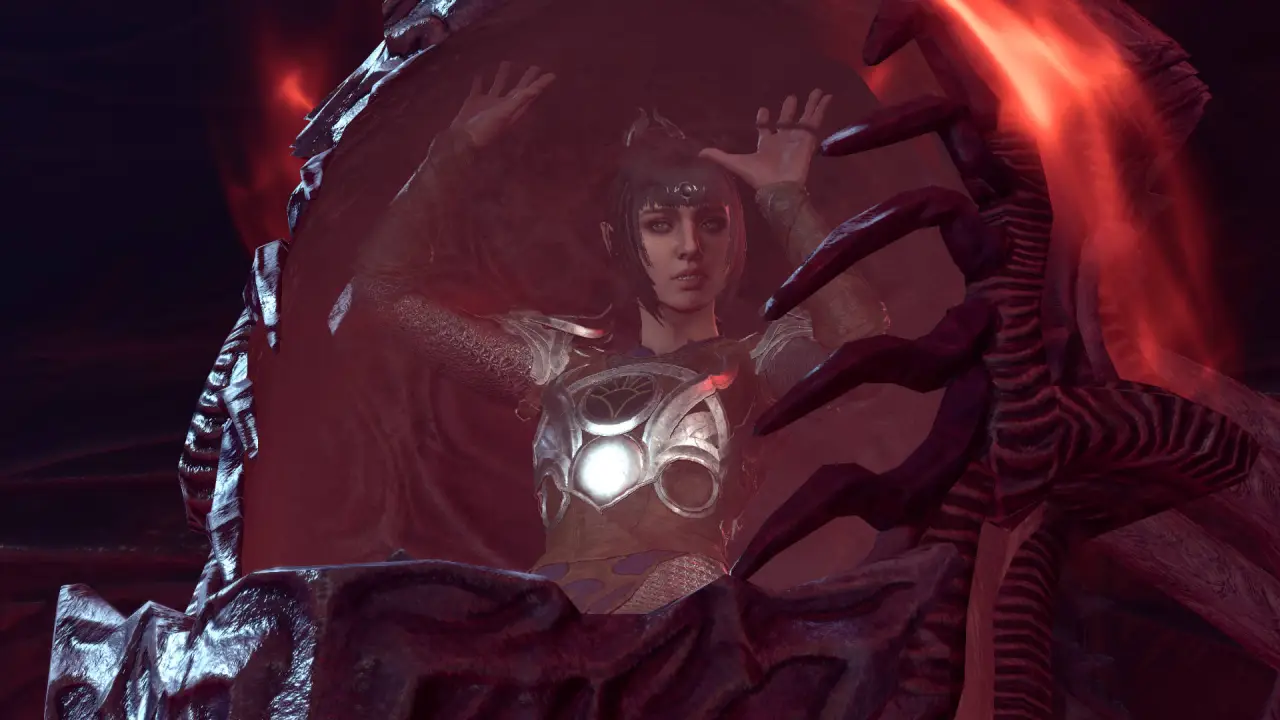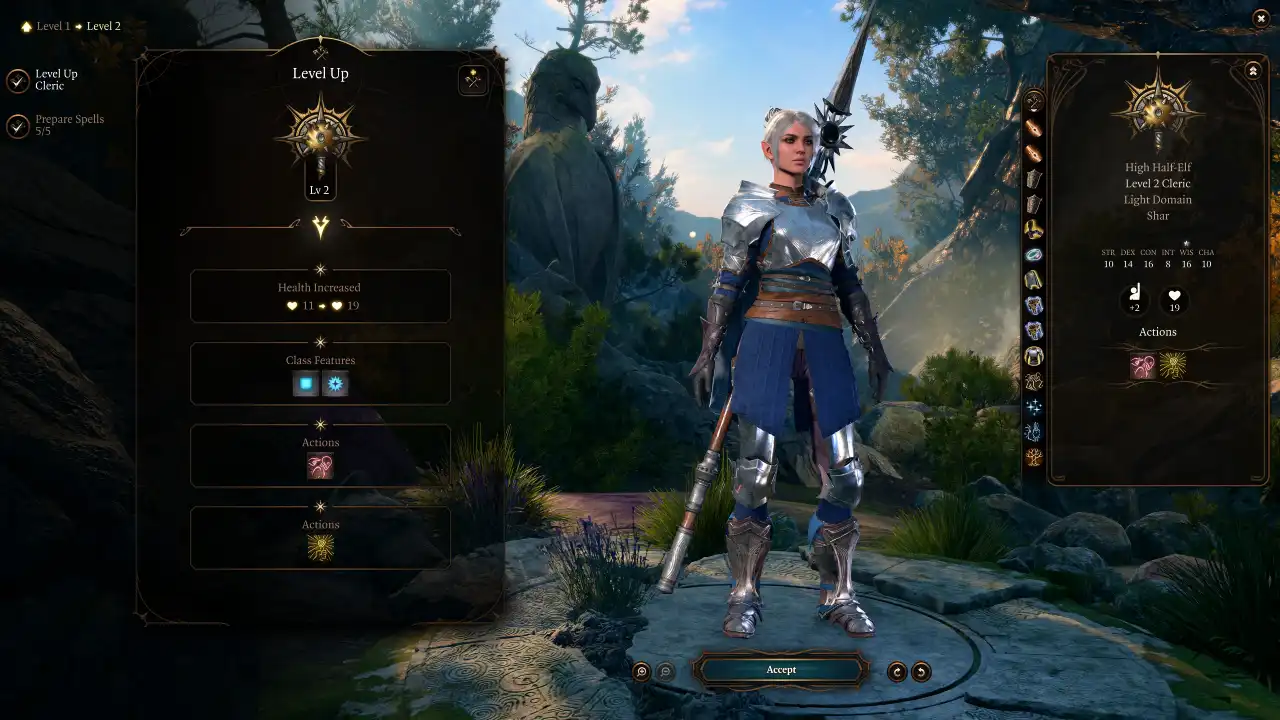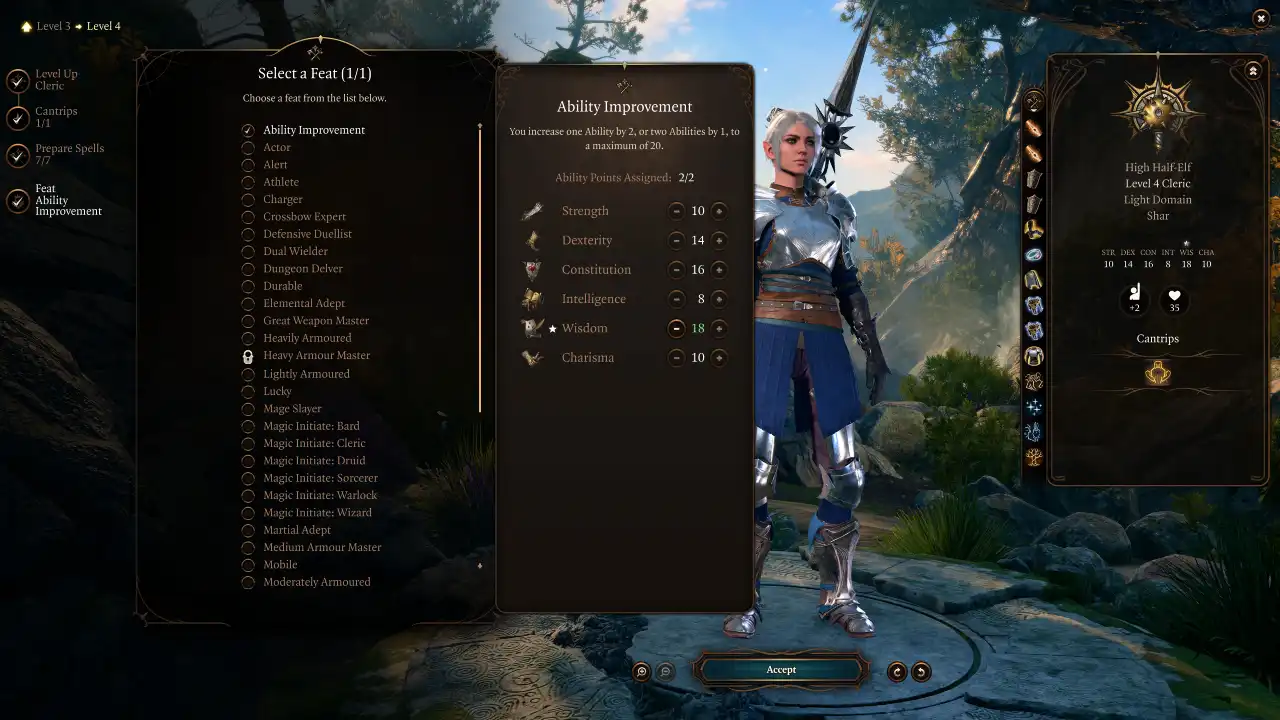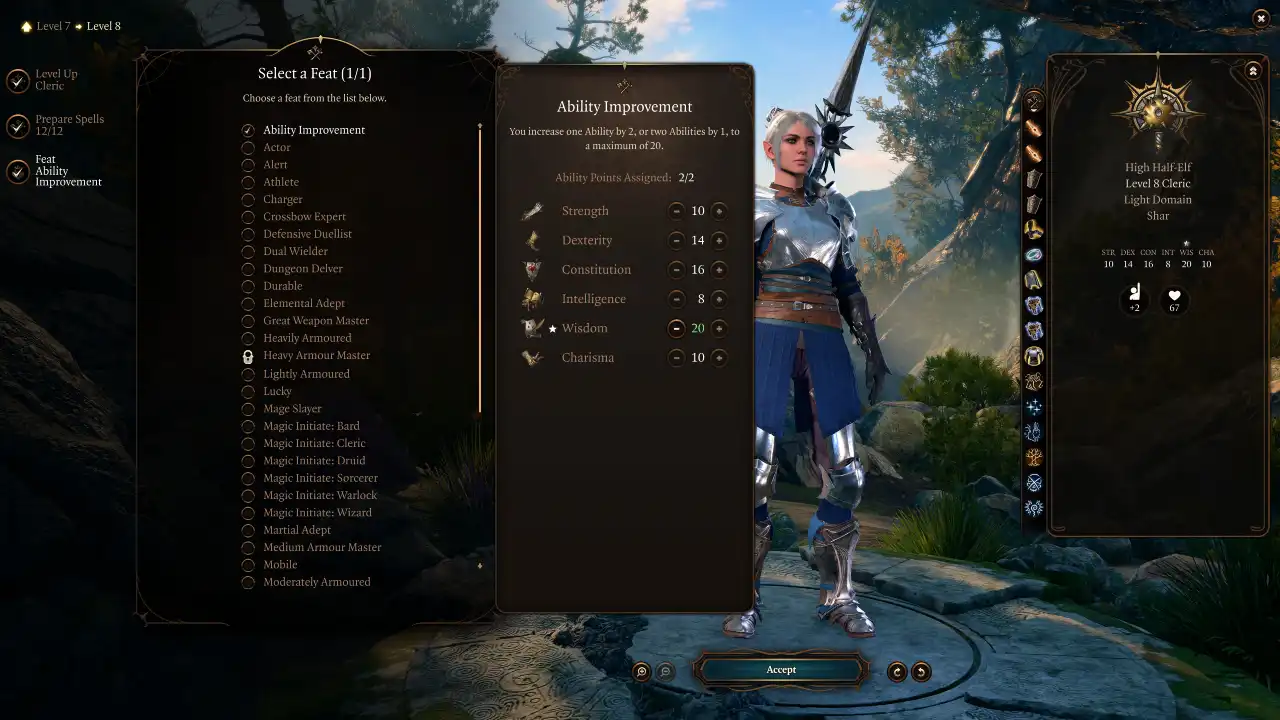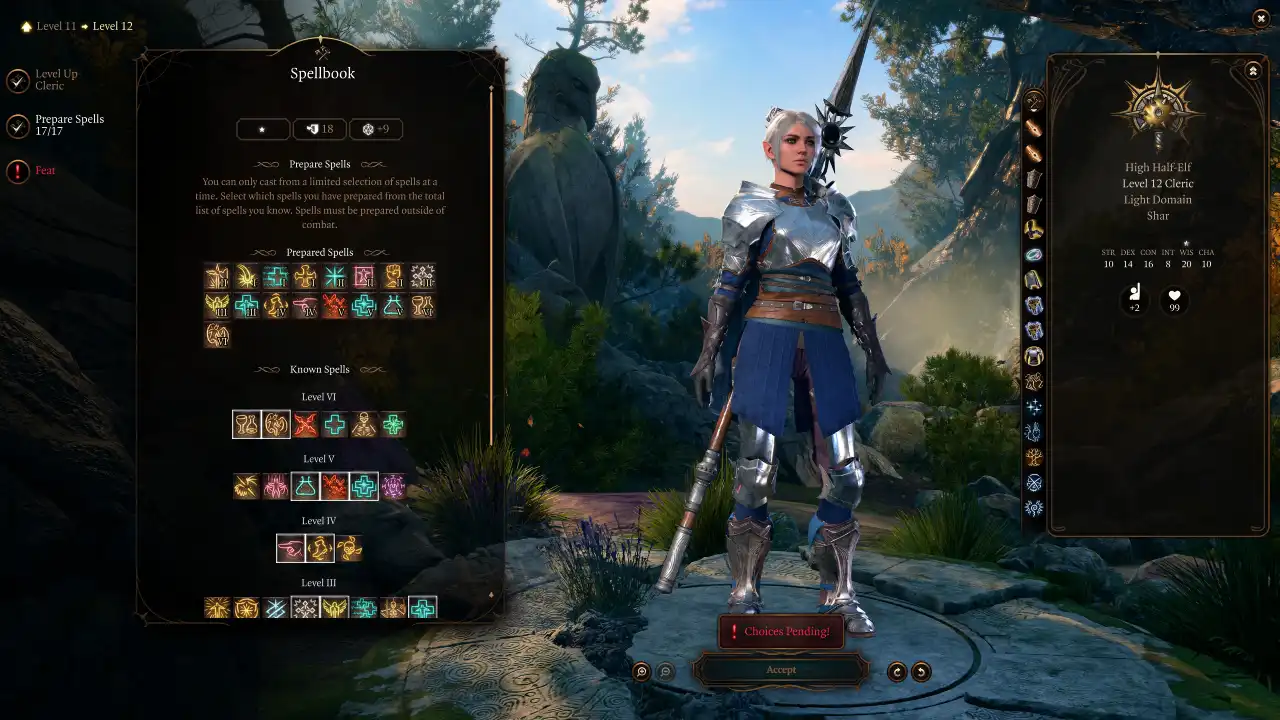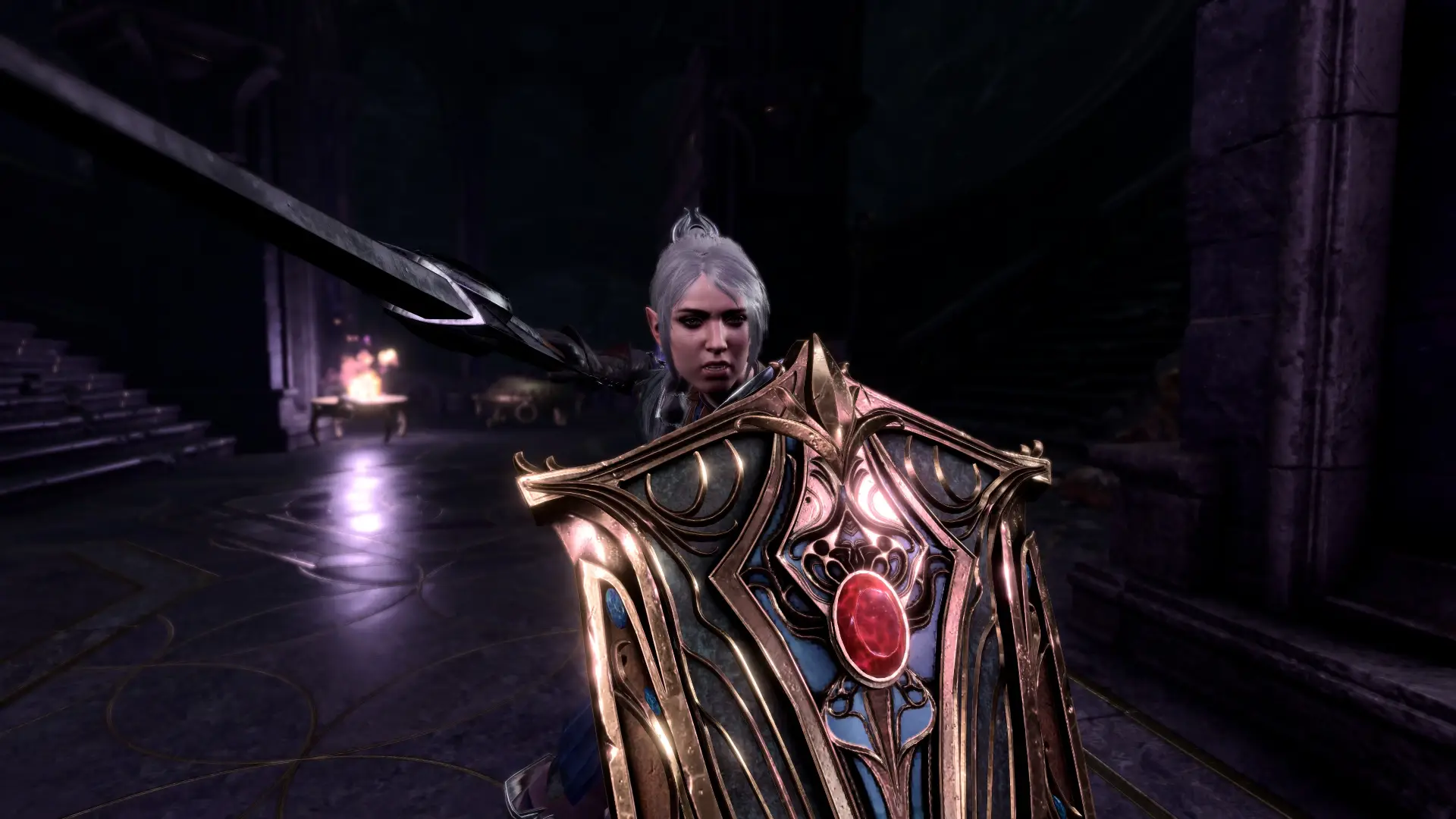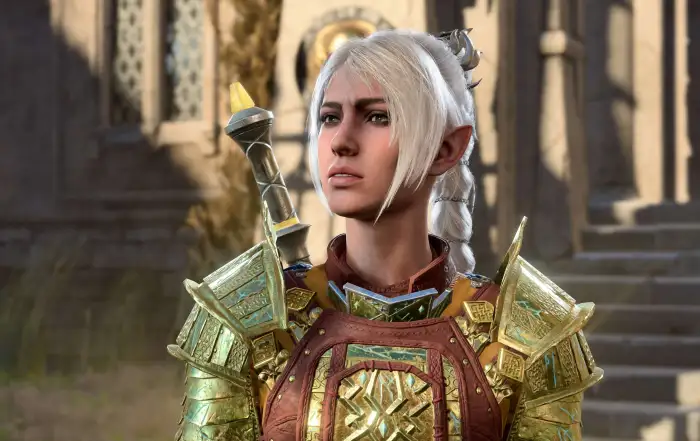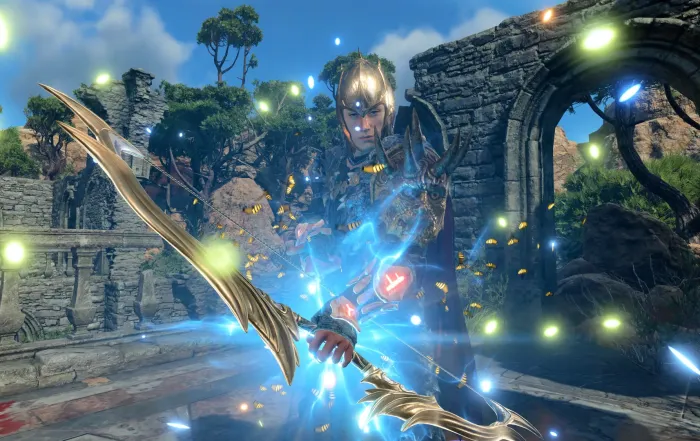Welcome to our Ultimate BG3 Shadowheart Build. Clerics like Shadowheart can be challenging to play for beginners because she sometimes feels weak early in the game. However, this guide will provide you with a very powerful Shadowheart Companion setup suitable for beginners and experienced players alike.
Table of Contents for the BG3 Shadowheart Build:
- Shadowheart Build – First Steps
- Shadowheart Build Starting Point
- Shadowheart Levelling Guide
- Shadowheart Equipment
- Shadowheart Build Extra Info
- Frequently Asked Questions
This build will work on any difficulty, and you can use it for other Clerics other than Shadowheart if you want. Our BG3 Shadowheart Build was last updated in October 2025. It works for PC and Console (PS5 and Xbox Series X/S).
While Shadowheart begins as a Trickery Domain Cleric, we’ll change that to Light Domain to make this build work and make her a better companion throughout the game. This makes the build especially thematically suited to a “good playthrough”, but that depends on whether you are concerned about roleplaying to that extent or not.
Please visit our Best BG3 Builds overview page for more builds. For more BG3 Cleric Builds, check out our Best BG3 Cleric Guide or BG3 Best Healer Cleric Build. If you are interested in builds for the other members of your party, check our BG3 Origin & Companion Builds category page. To get an overview of all classes, please visit the BG3 Classes overview page.
Shadowheart Build BG3 – First Steps
In this section, we will cover how to recruit Shadowheart in BG3 and how to respec her to Light Domain Cleric for this build. If you’re an experienced player who already knows this, you can just skip to the next part.
How to Recruit Shadowheart in BG3
Shadowheart is one of the most straightforward BG3 companions to recruit; in fact the game pushes you harder to recruit her than any other character. The quickest way to recruit her (and start off with the best possible relations) is to free her during the prologue and then find her on the beach:
- In the final room of the prologue before you climb up to the ship’s helm, you will find Shadowheart in a pod banging on the door.
- Head to the optional side-room (it has another pod in the middle of the room) and look around until you find the Eldritch Rune. Pick it up.
- Return to the console next to Shadowheart’s pod and use the Eldritch Rune to unlock it.
- Use the console to open the pod.
- Ask Shadowheart to join you and then complete the prologue.
- After the Prologue, walk along the beach slightly and you will find Shadowheart knocked out on the ground. Wake her up and get her to join you again.
- If you somehow missed Shadowheart in BG3, you can later find her banging on a door further up the beach at the side-entrance to the Dank Crypt. If you missed her for a really long time, she’ll turn up at the Druid Grove eventually as a last way to recruit her for this playthrough.
How to Respec Shadowheart in BG3
To follow this build guide precisely, you will need to respec Shadowheart. It is up to you when you do this, but I recommend getting it done by the time you reach Level 4. Here is a quick tutorial in case you don’t know how to respec characters in BG3:
- Recruit a full party, then head to the Refectory Ruins, roughly north of where you washed up on the beach. Enter the ruins either by brute force, stealth or sweet-talking the bandits outside.
- Fight your way through and find the Skull Lever to open the secret door to gain access to the Dank Crypt. If you can’t find the Skull Lever, you can instead go back outside and head to the side-entrance mentioned above. You’ll need to Lockpick your way through if you go this way.
- Once inside the Dank Crypt, head to the room with the skeletons and open a second secret door. This will cause several skeletons to attack you.
- Defeat the skeletons and head into the small room you opened. Interact with the big coffin and you will meet a friendly but mysterious skeleton called Withers.
- After you leave the Dank Crypt, Withers will join your camp.
- Once he is in your camp, speak to him as Shadowheart and ask him to change your class. This costs 100 gold.
- You can then select Cleric and Light Domain Cleric. Once you’ve done that, you’re all set to get started with this BG3 Shadowheart build.
Why We’re Using the Light Domain Subclass for Shadowheart
We’ll be using Light Domain Cleric for this Shadowheart Build for the following reasons:
Warding Flare – Use a
Reaction to impose
Disadvantage on an attacking enemy. Can be used to protect allies at higher levels.
Radiance of the Dawn – A large AoE that deals
Radiant Damage to many enemies at once. This is perhaps the strongest Cleric action in the game, and it can carry the party at early levels.
Fireball,
Flame Strike and other strong Domain Spells
Radiating Orb synergy – You can deal lots of
Radiant Damage, which makes you great at triggering equipment that applies the
Radiating Orb debuff. This will be vital for the build.
The Light Domain Cleric has more damage potential than other Clerics, helps to protect and heal your party, and with this build it can easily apply crippling debuffs on multiple enemies at once, making your playthrough much easier.
BG3 Shadowheart Build Starting Point
Here we will look at the BG3 Shadowheart Build’s status at Level 1, before we begin levelling up. This is how the build should look immediately after doing the respec to Light Domain.
Race: High Half-Elf
Shadowheart is a High Half-Elf. This race isn’t actually that great, and there are better picks for the Cleric, but it’s not possible to change Shadowheart’s race without modding the game, so it is what it is. One positive of High Half-Elf is the ability to choose an extra Cantrip from the Wizard list. These Cantrips all unfortunately use Intelligence as the spellcasting attribute, something that is not prioritised for Clerics, so you will struggle a lot to deal damage with these Cantrips. It’s therefore better to choose a supportive one like Blade Ward,
Friends or
Mage Hand.
You’ll also get Proficiency with Pikes, Spears, Halberds, and Glaives from your Human ancestry, and Advantage* on
Saving Throws against
Charm (and immunity to magical
Sleep) from your High Elf ancestry, as well as the
Darkvision passive feature.
The most useful things here are the Sleep immunity (Sleep is a really annoying control spell and a lot of enemies will spam it if a party member has low HP) and the
Darkvision (makes you more likely to hit enemies in dark places).
*Advantage – For the uninitiated, Advantage means that you roll two dice instead of one, and the highest number will be chosen for your roll. This substantially improves your chances of a successful outcome. On the contrary, a
Disadvantage means that you roll two dice and must use the lowest number for your roll. The same mechanics apply to the hidden dice rolls that happen in combat, so if a spell like
Guiding Bolt gives you
Advantage on your next
Attack Roll, then this is what it means.
Ability Point Distribution
In Baldur’s Gate 3, Shadowheart starts the game with an ability distribution that is a little suboptimal in my opinion. But when you respec her to the Light Domain Cleric, you will also have the opportunity to fix this.
I recommend starting with the following ability distribution:
10 Strength
14 Dexterity
16 Constitution
8 Intelligence
16 Wisdom
10 Charisma
Wisdom is the most important Cleric attribute, as all of your spells scale from this stat. Low Wisdom means less hit chance with most of your spells.
Constitution improves your HP and makes your Concentration Spells more likely to stay active after you take damage.
Dexterity improves your
Armour Class and makes you better at lockpicking. We’ll be wearing
Medium Armour, so we don’t need to increase
Dexterity above 14.
We have enough Constitution and
Dexterity here to see us through to the end of the game, so the only ability we will upgrade as we level up is
Wisdom.
Starting Cantrips
We recommend choosing the following Cleric Cantrips to begin with:
Guidance – This is a great ability for out-of-combat situations, and can be cast either on yourself or on an active ally from within the dice roll screen, letting you gain 1d4 boost to a range of dice rolls.
Resistance – Bolster the target’s defences, giving them a 1d4 bonus to
Saving Throws. This is a Concentration Spell. Can be used in some dialogue encounters in the same way as
Guidance, but these are a bit less common.
Sacred Flame – This is the Cleric’s main damage Cantrip. It suffers from low hit chance because enemies can perform a Wisdom
Saving Throw to completely block the damage. Still, there are situations in BG3 where
Radiant Damage is really good and I’ve seen this hit for over 80 damage, so it’s worth slotting as long as you know its limitations. Check the hit chance before casting, and if it’s below 70%, check for better options before proceeding.
Starting Spells
The following spells are a perfect fit for Shadowheart at Level 1:
Guiding Bolt – This is a must-pick, because it can deal up to 24 ranged damage right from the start of the game, which is very nice early-game damage. As a bonus, the next person to attack the target will have an
Advantage against them.
Healing Word – Useful for healing yourself or your allies. At first glance, you might wonder why we chose this instead of
Cure Wounds, which has a higher potential healing value. That’s because this skill can be cast at long range, while
Cure Wounds needs you to be in arms reach of the target, which just isn’t going to cut it. A good healing spell needs to be easy to use in all situations, and that’s what
Healing Word gives you.
Bless – Target up to three Allies, giving them a buff on
Attack Rolls and
Saving Throws. This improves the attack and defense of your allies, which can be really handy. Note that this is a Concentration Spell, so casting it will break any other Concentration effect you have active. Use this when fighting early-game boss enemies like the Gnolls on Risen Road – it’s going to help a lot while you’re stuck with weak early-game weapons. Keep Shadowheart safe from damage when she’s using a spell like this – on Tactician difficulty enemies will focus their attacks on anyone who is concentrating on a spell, so you’ll need to be doubly careful with this if you are playing on Tactician.
Inflict Wounds – Deals up to 30
Necrotic damage to an enemy. Can be upcast for more damage later in the game. The problem with this spell is that it only works in melee range. But it can hit really hard. Only use it when the hit chance is decent (at least 70%) otherwise it becomes another Sacred Flame situation.
You’ll also get a couple of extra Spells from the Light Domain subclass. These cannot be changed, but it’s worth giving them a mention anyway:
Burning Hands – Deals up to 18
Fire Damage in Melee range, and ignites anything flammable. I don’t use this spell much because the range is low, but it’s good if several enemies clump up in a small area.
Faerie Fire – An AOE spell that encases multiple targets in light, forcing them to be visible and causing any
Attack Rolls made against them to have
Advantage. This is a Concentration Spell so remember not to use it at the same time as
Bless! This spell can be really powerful, but sometimes you just get unlucky and all the targets succeed their Saving Throw.
Light (Cantrip) – Infuse an object with an aura of light. Occasionally useful, particularly if someone in your party lacks Darkvision. This will not light the way through magical darkness, however. You need the
Daylight spell for that.
BG3 Shadowheart Step-by-Step Levelling Guide
Now that we’ve covered the starting foundation of the build, we can begin looking at how you should progress the build as you level up.
Early-Game Levelling Process
We’ll start with the early-game levels, 2-4.
Level 2
At Level 2, you’ll gain a new Spell Slot for your Shadowheart Build in Baldur’s Gate 3, allowing you to cast an extra spell between Long Rests.
You’ll also unlock a special type of ability specific to the Cleric – Channel Divinity Actions.
Channel Divinity Actions have their own number of uses, separate from Spell Slots. To begin with, you only have one use, which can be replenished by either a Short or Long Rest.
With the Light Domain Cleric, you’ll unlock the following Channel Divinity Actions at Level 2:
Turn Undead – Present your holy symbol and pray. Each undead that can see or hear you is
Turned, and must spend its turns fleeing from you, until it takes damage.
Radiance of the Dawn – Harness the sun’s divine power to dispel any magical darkness and deal (2d10 + Cleric Level)
Radiant Damage to hostile creatures. On a successful
save, targets still take half damage. Doesn’t affect creatures that have total cover from you.
Turn Undead is quite a niche action that you won’t always have use for, but Radiance of the Dawn lets you deal decent damage to all enemies in the area. If you get a very good Damage Roll then you’ll be dealing over 20 damage to all enemies who don’t perform a Saving Throw. Look out for enemies who are vulnerable to Radiant damage, as you can get especially good value from Radiance of the Dawn against those enemies.
You also get one extra prepared spell slot. Select Create or Destroy Water. This is a nice spell that can help you extinguish fire in combat or during a quest.
Level 3 – Shadowheart Build BG3
At Level 3 for your Shadowheart Build, you unlock another First Level Spell Slot, as well as two Second Level Spell Slots.
There are a couple of Second Level Spells that would be great to prepare at this point:
Aid – Heals your allies within 9 metres for 5HP, and also increases their maximum HP by 5, until the next Long Rest. Use this after every Long Rest to improve your party’s health. Later on you can upcast the spell to increase the effect by 5HP per spell level.
Hold Person –
Hold a humanoid creature, making it unable to move and act. At the end of each turn, the creature can try to free itself with a
Saving Throw. This is a Concentration Spell. Melee attacks against the stunned creature are guaranteed crits, so this is especially good when combined with a melee heavy hitter in your party, like Karlach, Laezel or any other Fighter/Barbarian/Paladin.
You’ll also unlock a couple of new Domain Spells, which are spells that the Cleric will always have prepared (i.e they automatically go on your action bar without needing to choose them).
Flaming Sphere – Summon a flaming sphere that deals 2d6
Fire damage to nearby enemies and objects. It also sheds bright light in a 6 metre radius, and dim light for an additional 6 metres. On a successful
save, enemy creatures still take half damage. Requires Concentration, and will continue damaging enemies close to the sphere each turn.
Scorching Ray – Hurl three rays of fire. For each ray that hits, you deal 2d6
Fire damage. You can hurl the rays at one target or several. Later on, you can upcast the spell – each spell level will add another spell projectile. I often find this spell to be a bit disappointing, but when you get lucky and all of the Rays hit, it can do really good damage.
Also, keep in mind that some of the First Level Spells you already knew can now be upcasted to Second Level, improving their effects but consuming a second level spell slot instead.
I also want to point out the Prayer of Healing spell. This heals your entire party by a significant amount, but only outside combat. It’s especially useful on Tactician/Honour difficulty, where Camp Supplies are scarce. Use it to heal your party when you’re out of Short Rests but it feels too soon to take a Long Rest (because you have too many Spell Slots and action charges left, for example). Thanks to the Cleric’s ability to slot and unslot spells freely, you can do this whenever you want without needing to reserve a spot for it.
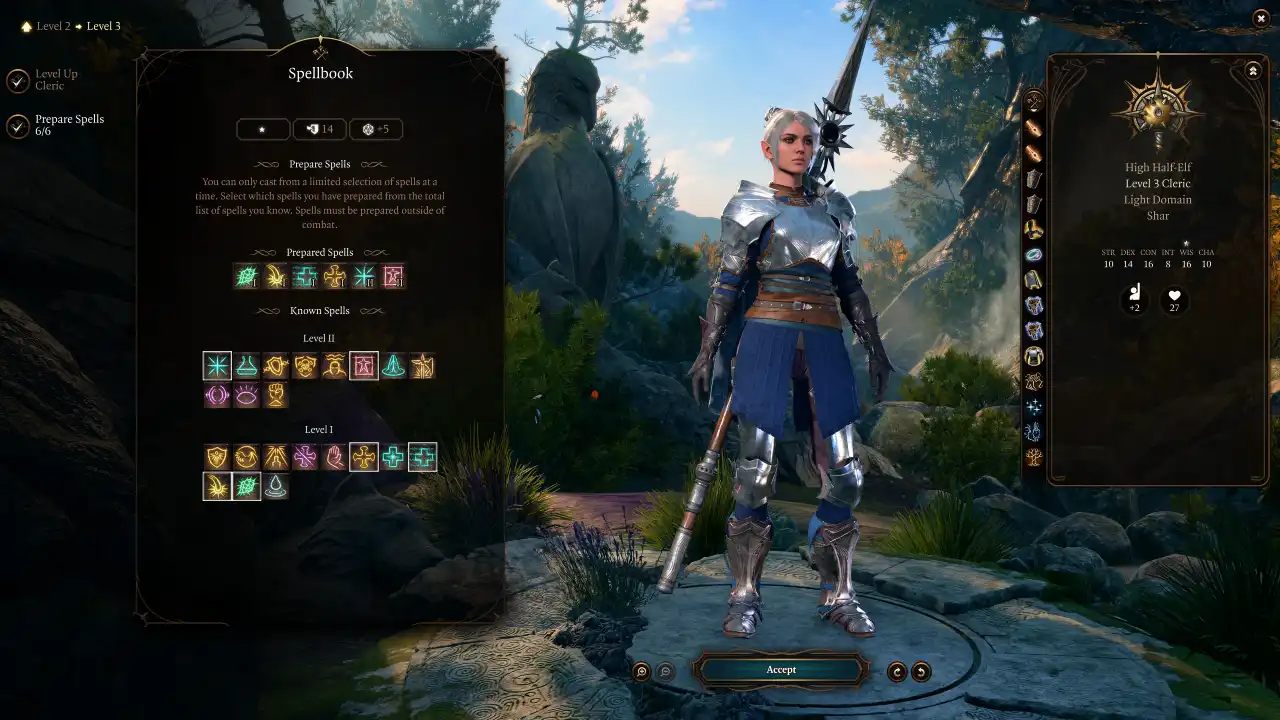
Level 4 – Shadowheart Build Baldur’s Gate 3 for PC/PS5
At Level 4, you’ll need to choose a Feat for your Cleric Build. Feats are powerful passive effects for your character that can enable a specific build or simply boost your stats. We strongly recommend choosing Ability Improvement, which will give you two additional Ability Points. Put them both into Wisdom, allowing you to reach 18 Wisdom. This will make your spells stronger.
You’ll also gain another First Level and Second Level Spell Slot, and you’ll need to choose another Cantrip. We’ll pick up Thaumaturgy, which occasionally is useful in dialogue checks.
You can slot two more spells now (one from levelling up, another from improving our Wisdom Modifier, you have to go into the spell menu to see the second slot). The following spells are great choices:
Spiritual Weapon – Summon a spiritual weapon to help you in combat. The weapon can be controlled and deals
Force Damage. This is good for dealing extra damage in the early-game, and it’s also good for distracting enemies when you’re outnumbered. Enemies will often waste their time attacking this instead of your party members. It only has 20 HP, but it is resistant to most damage, so it’s good for this purpose.
Enhance Ability – Choose an ability and give yourself or an ally
Advantage in all checks of that ability until you lose Concentration on the spell. This is a very powerful buff for both combat and non-combat situations, but it does prevent you from casting any other Concentration spells.
Mid-Game BG3 Shadowheart Build Levelling Guide
We’ll now go into the mid-game section of the levelling-up process for this Baldur’s Gate 3 Shadowheart Build, looking at levels 5-8.
Level 5 – Shadowheart Build Baldur’s Gate 3
At Level 5, Shadowheart’s Spellcasting ability further improves.
Firstly, the Turn Undead Action is now upgraded to Destroy Undead, which will now deal
Radiant Damage to undead who are
Turned by the Action.
You’ll also unlock two Third Level Spell Slots. While this build is quite flexible, and it’s up to you which spells you choose here, we recommend taking a close look at the following options:
Glyph of Warding – Inscribe a circle of arcane glyphs on the ground that trigger a magical effect when stepped on by an enemy. Only one glyph can be active at a time.
Revivify – Revive a companion. They return to life with 1 hit point. This is good because you no longer need to carry around Revivification Scrolls to revive casualties. I don’t recommend using it in combat unless you can immediately heal the person you revived.
Spirit Guardians – Create an AOE of either
Radiant or
Necrotic damage that follows Shadowheart, damaging and slowing down all enemies who enter. The Radiant version of this spell is especially good in areas with undead, as they tend to be weak to Radiant damage. Shadowheart can deal loads of damage by casting this and then running through a crowd of enemies. Just beware of opportunist attacks if you do this.
Luckily, Clerics like Shadowheart can change their prepared spells at any time (as long as they aren’t in combat) by accessing the Spells menu. So if you don’t like your choices, keep trying new spells until you find ones you like.
Finally, you’ll unlock another two Domain Spells at Level 5:
Daylight – Enchant an item to shine like the sun or summon a sphere of sunlight that dispels all darkness around it.
Fireball – Shoot a bright flame from your fingers that explodes upon contact, torching everything in the vicinity for 8d6
Fire Damage. On a successful
save, targets still take half damage.
Fireball is another strong spell that has very high damage potential. It’s an AOE that can roll for up to 48 damage, and deals a minimum of 8 damage. If you have clear line of sight to a cluster of enemies then this is really good option. Daylight is useful in the early parts of Act II (no spoilers here, though).
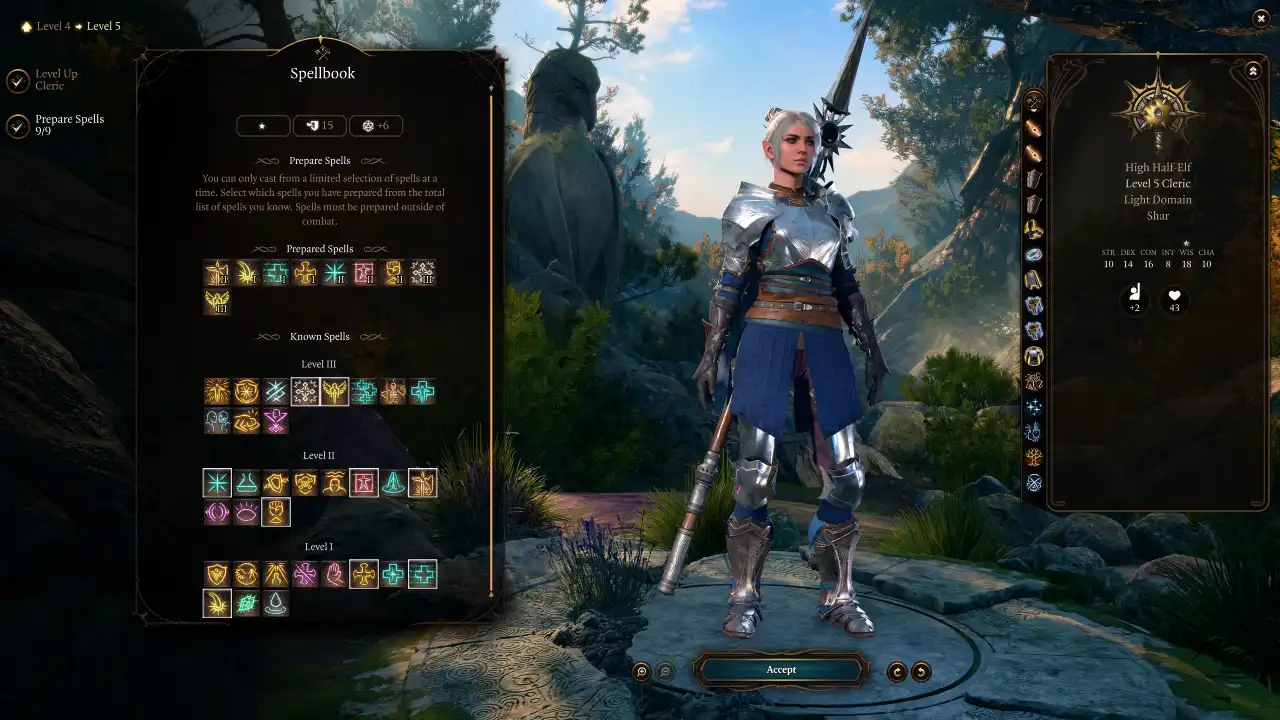
Level 6
At Level 6, Shadowheart gains a couple of new features:
- An extra Channel Divinity Charge, allowing you to use two Channel Divinity Actions per Short/Long Rest.
- Another Third Level Spell Slot, giving you three in total.
- Prepare one more Spell. Choose one of the spells from Level 5 that you didn’t get yet.
Revivify is great, it allows you to resurrect group members without a resurrection scroll.
That’s basically all you get at Level 6, but fortunately, there’s a lot more to come at the next level.

Level 7
At Level 7, you unlock the following:
- One Fourth Level Spell Slot, and the ability to Prepare Fourth Level Spells.
- Two more Spells from your chosen Domain (always Prepared). The Light Domain Cleric gets:
Guardian of Faith – Summons an immobile Guardian. On his turn, he attacks a nearby enemy for 20
Radiant Damage. Enemies who move or attack while within range of the Guardian are also attacked. Every time the Guardian attacks, he also deals 20
Radiant Damage to himself.
Wall of Fire – Create a blazing wall of fire, burning anyone who dares stand too close for 5-40
Fire Damage. Requires Concentration to maintain.
- One more spot for a Prepared Spell. We recommend getting
Freedom of Movement, an excellent situational spell that allows you to snap an ally out of any stun or immobilising effect. This spell has been a life-saver for me several times. The only drawback is that you need to be next to the target.

Level 8
At Level 8, you unlock:
- Potent Spellcasting – Add your Wisdom modifier to damage you deal with Cantrips.
- Another Fourth Level Spell Slot, giving you two in total.
- Choose another Feat. We recommend getting Ability Improvement and putting both points into
Wisdom, increasing it to 20. This will give you the best possible spellcasting odds for your Cleric.
- Prepare two more Spells. Sadly, there aren’t many more good options for now.
Banishment can occasionally be useful but it’s very situational, and
Death Ward is generally a waste of a spell in my view. Still, grab them for now, and we’ll replace them on the next level when we unlock better options.
While your Cantrips still suffer from a fairly poor hit chance with Cleric, keep an eye out for opportunities where they’re likely to hit so you can make use of the new Potent Spellcasting buff. Sacred Flame, in particular, can hit really hard when it’s used properly, but there’s little point using it if the hit chance is too low.
Late-Game BG3 Shadowheart Build Levelling Guide
We’ll now look at the late-game section of the levelling guide, covering levels 9-12.
Level 9
At Level 9, Shadowheart’s spellcasting continues to improve, as you can now access even more powerful spells. Here you’ll unlock:
- Another Fourth Level Spell Slot, giving you three in total.
- One Fifth Level Spell Slot, and the ability to prepare Fifth Level Spells.
- Two more Domain Spells from your subclass. Light Domain Cleric gets:
Destructive Wave – Create a shockwave of either divine or malevolent thunder that damages nearby creatures and possibly knocks them prone. Choose from 5-30
Thunder and 5-30
Radiant or
Necrotic Damage.
Flame Strike – Make a pillar of divine fire roar down from the heavens like the wrath of affronted angels. Deals 5-30
Fire and 5-30
Radiant Damage, unless the target rolls a Dexterity
Saving Throw.
- Prepare one more spell, plus another two more to replace Death Ward and Banishment from Level 8:
Dispel Evil and Good – Allows you to dispel mind-controlling conditions (
Charmed,
Frightened,
Possessed). While active, Aberrations, Celestials, Elementals, Fiends, Fey and Undead have
Disadvantage when attacking you.
Insect Plague – Locusts attack everyone within a 12 metre area, dealing 4-40 Piercing Damage, making the area Difficult Terrain, and imposing
Disadvantage on
Perception Checks. Damage is halved on targets that roll a Constitution
Saving Throw. This is one of the best spells in the Cleric’s arsenal, and can turn a chokepoint into a deadly killzone that enemies will really struggle to penetrate. Especially useful in Act III due to the narrow streets and tunnels, which make chokepoint tactics especially good.
Mass Cure Wounds – A good multi-target healing spell.
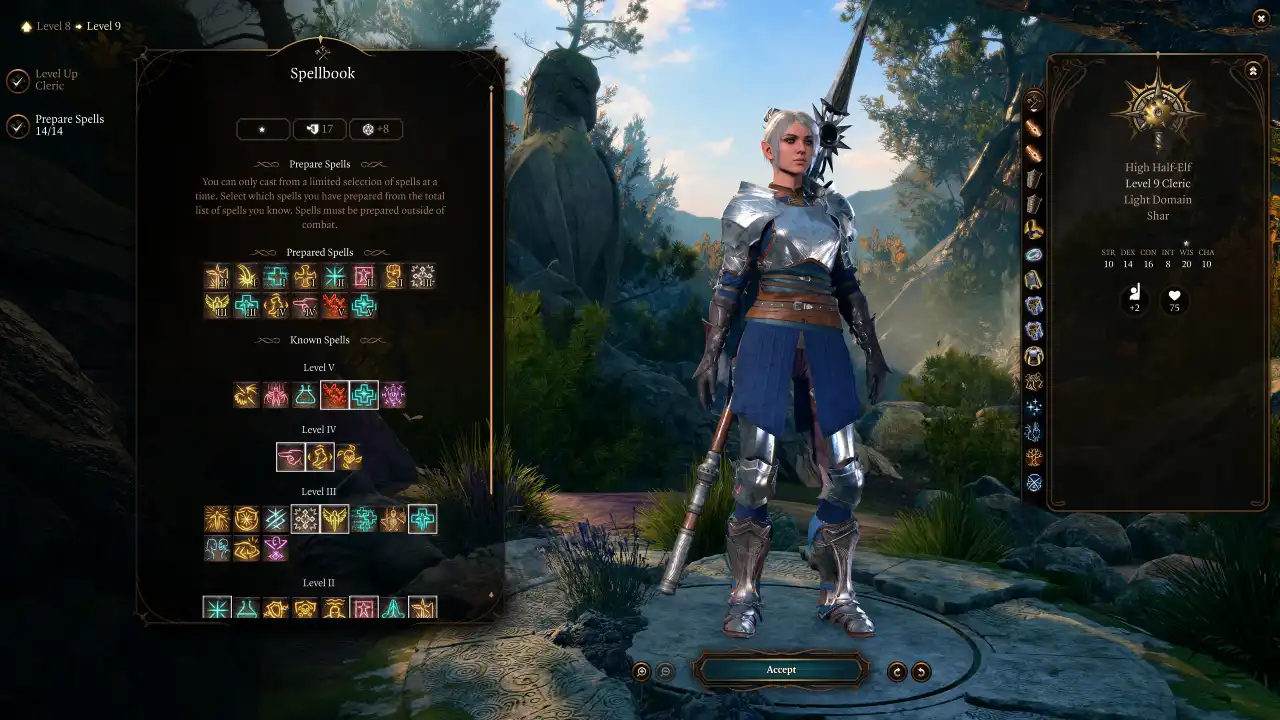
Level 10
At Level 10, Shadowheart unlocks another spell and the ability to get a one-off boon from Shar or Selune. You gain:
- Another Fifth Level Spell Slot, giving you two in total.
- Choose one more Cantrip. We already picked up the most important Cantrips, so you can choose whatever you like here.
Divine Intervention – Once per character, invoke your god’s aid. When activating this, you can choose from:
Sunder the Heretical – Deal 8-80
Radiant Damage to a group of enemies.
Arm Thy Servant – Grants you a Legendary weapon.
Opulent Revival – Resurrect fallen Companions with half health and restore nearby allies as if they had Long Rested.
Golden Generosity – Provides a rich bounty of Potions and Camp Supplies.
- Prepare one more Spell.
Greater Restoration is a good option – it allows you to cure a range of Conditions and debuffs from your allies.
Divine Intervention is a potentially good passive for helping you out in a pinch. But beware that this can only be used once per character. There is no way to recharge the ability.

Level 11
At Level 11, you don’t gain any new class abilities, but you do get access to Sixth Level Spells, the most powerful tier of magic in Baldur’s Gate 3.
You’ll gain one Sixth Level Spell Slot, and as usual, you’ll be able to prepare one more Spell.
I highly recommend the Heroes’ Feast spell, which gives another strong defensive buff to your whole party to use alongside the
Aid spell. It also adds some Camping Supplies to your inventory, which should put an end to any problems you have with having enough supplies for Long Rests. Use the spell after every Long Rest along with the upcasted
Aid spell – this will make your party much stronger.

Level 12
If you’ve reached this point, then you have finished levelling up your Cleric to the max level. Congratulations!
At Level 12, you can choose one more Feat for your Cleric Build. Picking up War Caster is a good idea, as it gives you
Advantage on Concentration Checks. Since the Cleric often spends a lot of time in close proximity to enemies while also spellcasting, this is really helpful for making your Concentration Spells more resilient. As a bonus, War Caster also lets you zap enemies who get too close with lightning.
You can also choose one more Spell to prepare. Planar Ally allows you to summon a powerful creature to fight alongside you, not only dealing good damage to enemies but also redirecting some enemy attacks toward your summoned creature rather than your party members.
Shadowheart Build Equipment for Baldur’s Gate 3
In this section, we will outline the best equipment recommendations for Shadowheart in BG3. We have included both an early game and a late game section for equipment, so you can use this build no matter how far through the game you are.
Don’t worry if you don’t have all of the listed equipment, and feel free to try out different items and combinations too – this is just a guideline and the build can still work great with some of the equipment changed.
Early-Game Gear
Early-Game equipment is available in Act I and the earlier parts of Act II. It is generally less powerful than the late-game version of the build, however there are still some really handy items that you can find fairly early on in your BG3 playthrough.
You can check below the table for more detailed information about each item, including how to obtain them.
| Slot | Icon | Item | Effects | Location |
|---|---|---|---|---|
| Head |  |
Wapira’s Crown |
|
Reward from Zevlor for completing the Save the Refugees quest |
| Cloak |  |
Cloak of Protection |
|
Purchased from Quartermaster Talli in Last Light Inn |
| Chest |  |
Luminous Armour |
|
In an opulent chest in the Selunite Outpost. |
| Gloves |  |
Luminous Gloves |
|
Inside the Potter’s Chest in the Ruined Battlefield |
| Boots |  |
Vital Conduit Boots |
|
Sold by A’jak’nir Jeera in Crèche Y’llek |
| Necklace |  |
Pearl of Power Amulet |
|
Sold by Omeluum in the Myconid Colony |
| Ring 1 |  |
Coruscation Ring |
|
In a chest hidden in the cellar of Last Light Inn |
| Ring 2 |  |
The Whispering Promise |
|
Act I Vendors – Volo or Grat the Trader |
| Main Weapon |  |
The Blood of Lathander |
|
In the secret area in Rosymorn Monastery, accessed by solving the statue puzzle near where you meet Vlaakith’s projection. |
| Shield |  |
Shield of Devotion |
|
Sold by Quartermaster Talli in Last Light Inn |
| Second Weapon | Any with Proficiency |
|
N/A |
This is one of the best support setups available this early in the game, and is perfectly suited to a Cleric like Shadowheart.
This setup has the following purposes:
- Radiating Orb debuff – Stack the Radiating Orb debuff to apply an Attack Roll penalty of up to -10 on enemies, crippling their ability to hit you.
- Luminous Armour
- Luminous Gloves
- Coruscation Ring
- Blood of Lathander (illuminates nearby enemies so the Coruscation Ring will trigger more easily, and gives early access to the Sunbeam spell)
- Extra buffs on healing – Additional effects triggered on healing, namely Blessing the target and giving healing to Shadowheart when she heals an ally.
- The Whispering Promise
- Wapira’s Crown
- Defensive Items – These are mainly chosen because they make it easier to stay alive
- Cloak of Protection
- Vital Conduit Boots
- Shield of Devotion
Late-Game Gear
Late-Game Equipment is found in Act III and the latter parts of Act II, however some items from the early-game may also find their way onto this list, if they are powerful enough to remain competitive with items found in the latter parts of the game.
At this stage of the game we are mainly focusing on finding items that improve our Spell Save Difficulty Class – increasing this stat means that enemies need to roll a higher number to succeed a Saving Throw against our spells.
| Slot | Icon | Item | Effects | Location |
|---|---|---|---|---|
| Head |  |
Hood of the Weave |
|
Sold by Mystic Carrion in Philgrave’s Mansion |
| Cloak |  |
Cloak of the Weave |
|
Sold by Helsik at the Devil’s Fee, once her special stock has been unlocked. |
| Chest |  |
Luminous Armour |
|
In an opulent chest in the Selunite Outpost. |
| Gloves |  |
Luminous Gloves |
|
Inside the Potter’s Chest in the Ruined Battlefield |
| Boots |  |
Helldusk Boots |
|
In a locked Gilded Chest on the top floor of Wyrm’s Rock Fortress |
| Necklace |  |
Amulet of the Devout |
|
Found in the main offering chest in the basement of Stormshore Tabernacle |
| Ring 1 |  |
Coruscation Ring |
|
In a chest hidden in the cellar of Last Light Inn |
| Ring 2 |  |
Callous Glow Ring |
|
In an opulent chest in the vault room of the Gauntlet of Shar |
| Main Weapon |  |
The Blood of Lathander |
|
In the secret area in Rosymorn Monastery, accessed by solving the statue puzzle near where you meet Vlaakith’s projection. |
| Shield | Viconia’s Walking Fortress |
|
Looted from Viconia DeVir in the Cloister of Sombre Embrace | |
| Second Weapon | Any with Proficiency |
|
N/A |
We’ve kept a number of items from the early-game, most notably all of the Radiant Orb items and the Blood of Lathander. Most of the new items are aimed at increasing Shadowheart’s Spell Save Difficulty Class, which makes it harder for enemies to succeed Saving Throws against her spells.
- Radiating Orb – Mostly the same as in early-game, except we now have the Callous Glow Ring which deals 2 extra Radiant Damage when you hit an illuminated enemy, which will in turn trigger all of the other Radiating Orb items. This allows you to trigger them twice per attack, if your initial attack dealt Radiant Damage.
- Luminous Armour
- Luminous Gloves
- Coruscation Ring
- Callous Glow Ring
- The Blood of Lathander
- Spell Save DC – This stat determines how high enemies need to roll to win a Saving Throw against a spell cast by Shadowheart. We have several items to increase it, making her spells more potent:
- Hood of the Weave
- Cloak of the Weave
- Amulet of the Devout
- Survivability & Mobility – These items help Shadowheart to stay alive and prevent her from being pinned down by enemies
- Helldusk Boots
- Viconia’s Walking Fortress
Shadowheart Build Extra Info
Below is some extra information about this BG3 Shadowheart Build, such as tips for playing the build as you progress through the game, how you can use Illithid Powers (entirely optional) and how the build changed in Patch 8, the final major update expected for Baldur’s Gate 3.
How to Play Shadowheart in BG3
Now that we’ve fully explained the process of creating this Shadowheart build for Baldur’s Gate 3, we will give you some tips about using the build.
Early-Game Shadowheart BG3 Strategy
This BG3 Shadowheart build is obviously weakest when you are low-level, but this can be a particular problem for Shadowheart and other Clerics. Their attacks tend to be rather weak early on, and they don’t have many reliable damage options from spells and cantrips either. Inflict Wounds is your best damage source early in the game, but it often has a low hit chance.
To counteract these problems:
- I recommend being especially careful with your Actions early in the game so you don’t waste turns.
- Attack when there are good opportunities, but otherwise, you are best off focusing on supporting and healing allies and debuffing enemies.
- Once you obtain some of the
Radiating Orb equipment (like the Luminous Armour and Gloves) you can start debuffing enemies quite easily, especially when you combine this with the Light Domain’s
Radiance of the Dawn action, which deals strong
Radiant Damage in a large AOE and can apply many stacks of Radiating Orb to nearby enemies.
This state of affairs lasts until you reach Level 5, at which point Shadowheart starts unlocking some much better spells.
Mid-Game Shadowheart BG3 Strategy
In the Mid-Game, Shadowheart is stronger, with a more useful range of spells and abilities.
Spirit Guardians is especially good, because many enemies in Act II are weak to
Radiant Damage.
- Act II is also a very interesting time in Shadowheart’s story, so make sure to explore the Shadow-Cursed Lands fully and don’t miss anything important here.
- Despite the stronger spells, in many fights you’ll still be best off with supporting allies as Shadowheart for now, since we’re still lacking the late-game Cleric spells.
- If you’ve been collecting the recommended equipment then by now you should be able to put crippling debuffs on enemies with
Radiating Orb, even making boss enemies greatly struggle to hit you.
- You have good AOE damage potential from spells like
Spirit Guardians,
Glyph of Warding and
Fireball. Utilize these, but be wary of Concentration checks.
Important: Keep looking for ways to activate the Radiating Orb equipment – I can’t stress enough how strong the debuff is.
Late-Game Shadowheart BG3 Strategy
Once you reach level 9 and above, you’ll start unlocking spells like Insect Plague and
Flame Strike.
Insect Plague is the best offensive spell in Shadowheart’s arsenal, as it puts a massive movement speed debuff on anyone caught within and deals up to 40
Piercing Damage per turn. It works amazingly well in chokepoints where enemies cannot find another way to reach you. Dropping it on top of a cluster of enemies can also be really strong, even if they’re not in a chokepoint.
- If you want a larger burst of damage immediately, you’re usually better off using
Flame Strike instead.
- For maximum single-target damage, upcast
Inflict Wounds to Spell Level 4 or 5. This old level 1 spell scales really well when upcast, and can crit in excess of 100 damage if you’re lucky.
- Make sure to keep buffing your party’s HP by upcasting
Aid after every Long Rest, and when you hit Level 11, you can also add
Heroes’ Feast to this routine. This makes your party much stronger.
We hope you liked this Shadowheart companion build for BG3 (Baldur’s Gate 3).
Best Party Composition for Shadowheart
Shadowheart is quite uniquely placed in terms of her moral alignment. She starts the game with a Neutral alignment that leans slightly towards Neutral Evil because of her Sharran faith, but it quickly becomes apparent that there is some good in her. Shadowheart is also very pliable, more so than any other recruitable character, and she can be influenced to a good or evil alignment depending on the player’s choices.
This means that Shadowheart fits easily into any party, and you shouldn’t have any issues building a positive rapport with her, whether you play in a good, evil or neutral manner. To truly upset Shadowheart, you have to do it on purpose by being comically evil all the time, insulting her and invading her privacy.
BG3 Shadowheart Build Patch 8 Changes
While BG3’s Patch 8 added a lot of new content to the game, including five powerful new spells, the changes impacting this Shadowheart Build were minimal. The Radiating Orb equipment remained unchanged, as did the actions, spells and cantrips used in this guide.
What Patch 8 did bring to the table is two new Cantrips, which you can use on Shadowheart if you want:
Bursting Sinew – Create an explosion from an intact corpse, dealing
Piercing Damage to all nearby creatures. This is very situational, but skilled players can manipulate the battlefield to create situations where multiple enemies may fall victim to this spell several times over. While it doesn’t fit well into the build’s theme, it is a strong option that you may want to try regardless.
Toll the Dead – Deals 1d12
Necrotic Damage against a target, or 1d8 if the target is full HP. The damage scales up at Levels 5 and 10. This is functionally very similar to
Sacred Flame – it is a single-target ranged cantrip that carries a risk of dealing no damage at all if the target wins their
Saving Throw. The main difference is that Toll the Dead has higher damage potential, but it is much less effective at triggering
Radiating Orb because it doesn’t deal
Radiant damage. My advice would be to use Toll the Dead until you find your first Luminous equipment, then switch to Sacred Flame, but it is a trivial matter as you’ll usually have more reliable ways to deal Radiant Damage – if you’ve exhausted them all, then it’s probably time for a Long Rest soon.
That is all that changed with Patch 8, so you can rest assured that this build will still work perfectly in the latest version of BG3.
Cleric Build Illithid Powers (optional)
Illithid Powers are unlocked later in BG3 when you learn more about Mind Flayers and Tadpoles. By eating Jars of Mind Flayer Parasites you gain one point. This is another optional skill tree that you can get access to if you want. Here are some of the best Illithid Powers for the BG3 Shadowheart Build:
Concentrated Blast: Allows you to deal extra damage to a target when you are Concentrating on a spell, potentially also healing if the target is Concentrating too.
Cull the Weak: When you reduce a creature’s hit points below a certain threshold, this power instantly kills it and deals 1-4
Psychic Damage to nearby enemies. This is particularly effective when engaging groups of weaker foes, enabling you to thin their numbers rapidly. You have quite a few AoE spells, which are pretty good at activating this effect.
Fly: This can be used to reach hard to get to places or change positions in combat.
Black Hole: This power creates an area-based effect that pulls in and slows targets. It’s particularly useful for crowd control, allowing you to cluster enemies together for area-of-effect attacks or to isolate them from vulnerable allies.
Psionic Backlash: This is a top-tier
Reaction from the Illithid Powers skill tree in BG3. This allows you to deal
Psychic Damage when a nearby enemy casts a spell. This is especially useful if the target is casting a Concentration Spell. The damage from Psionic Backlash can immediately break their Concentration, ending the spell’s effects.
Frequently Asked Questions
This Shadowheart Build is mostly beginner-friendly. If you follow the recommendations in the guide, the build will make your playthrough easier by applying severe debuffs to enemies. However, the Cleric can be a tricky class to use in the early game (before level 5) because you initially don’t have many good spells and not much equipment. The good news is that Shadowheart makes for a good healer in these early levels, even though her damage output isn’t great.
Illithid Powers are not required for this build, and don’t have any especially important synergies with it. You can use them if you like, but it’s completely optional. The build is capable of finishing the game on any difficulty without using any Illithid Powers.
Yes. This build works on any difficulty, and is especially useful on Tactician and Honour difficulty because the Radiating Orb debuff makes it much harder for enemies to hit your party. On Tactician and Honour, enemies have a boost to their Attack Rolls, but with this debuff you can completely negate that.



